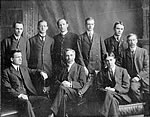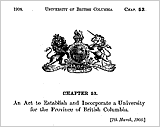 Several years of political debate in British Columbia beginning early
in the last decade of the nineteenth century resulted in the establishment
of McGill University College of B.C. which, beginning in 1907, provided
higher education in the province. This development, however, did little
to discourage the efforts of those interested in establishing a provincial
university. Although the administrative and financial foundations for
the University of British Columbia were well and truly laid by 1908,
the institution did not open its doors until 1915, and another decade
would pass before the dream of a new campus could be realized.
Several years of political debate in British Columbia beginning early
in the last decade of the nineteenth century resulted in the establishment
of McGill University College of B.C. which, beginning in 1907, provided
higher education in the province. This development, however, did little
to discourage the efforts of those interested in establishing a provincial
university. Although the administrative and financial foundations for
the University of British Columbia were well and truly laid by 1908,
the institution did not open its doors until 1915, and another decade
would pass before the dream of a new campus could be realized.
Discussion around the establishment of McGill University College of B.C. rekindled interest in the development of a provincial university. Premier Richard McBride delegated responsibility for addressing the growing demands for a provincial university to the new Minister of Education, Henry E. Young. In light of the competing demands for funds from the Provincial Treasury, Young embraced the idea of establishing a land endowment to generate revenue for the establishment and maintenance of a provincial university. In March 1907, he introduced An Act to Aid the University of British Columbia by a Reservation of Provincial Lands.
Passed one month later, the Endowment Land Act empowered the Lieutenant-Governor in Council to reserve up to two million acres, with the revenue derived from the sale of the land or other disposition to be used for the maintenance of the University. Premier McBride speculated that the proposed reserve could produce an annual income of perhaps $200,000 and stated that the agricultural lands located in the northern and interior parts of the province would perhaps have a value to $2 to $3 per an acre. Initially, the land for the endowment was to be selected within a three-year period. This selection period was extended on three separate occasions, each for a three-year period.
 Having addressed some of the University's financial needs, Young next
turned his attention toward the legal and organizational infrastructure
of the new institution. After consultations with other Canadian universities,
Young's An Act to Establish and Incorporate a University for the
Province of British Columbia passed without amendment in March
1908.
Having addressed some of the University's financial needs, Young next
turned his attention toward the legal and organizational infrastructure
of the new institution. After consultations with other Canadian universities,
Young's An Act to Establish and Incorporate a University for the
Province of British Columbia passed without amendment in March
1908.
With the administrative and financial infrastructure in place for the establishment of a provincial university, committees formed in Vancouver, New Westminster, Victoria and several other cities throughout the province to lobby to become the site of the new institution.
The provincial government appointed a board of distinguished educationalists from outside the province to consider the vexing question of selecting a site for the new university early in 1910. The Site Commission spent the summer travelling to several cities to inspect possible sites, hearing delegates, and reviewing submissions from a variety of groups representing various proposed locations.
 The
Commission's final report indicated that members were "strongly of the
opinion that the University should not be placed on a site which may
in turn be surrounded by a city." The Commission suggested that "not
less than 250 acres be set apart for the University Campus and 700 acres
for experimental purposes in agriculture and forestry." In making a
final determination on the location of the new provincial university,
the report offered the following comments:
The
Commission's final report indicated that members were "strongly of the
opinion that the University should not be placed on a site which may
in turn be surrounded by a city." The Commission suggested that "not
less than 250 acres be set apart for the University Campus and 700 acres
for experimental purposes in agriculture and forestry." In making a
final determination on the location of the new provincial university,
the report offered the following comments:
... the most suitable site is at Point Grey unless the soil there and that of the delta adjacent are found to be unsuitable for the experimental work of the College of Agriculture. Should Point Grey prove impossible, the Commissioners suggest - first a site along the shore west of North Vancouver, provided the tunnel and bridge are constructed; second, St. Mary's Hill overlooking the Pitt, Fraser and Coquitlam Rivers, provided residences are erected for the students. Central Park, though conveniently located, will probably be surrounded by the Cities of Vancouver and New Westminster, and because of this and the absence of outstanding scenic advantage is undesirable.
The Government acted quickly and in December 1910 reserved 175 acres of land for the University campus on the Point Grey site. A subsequent grant for agricultural land in 1915 expanded the campus site to approximately 550 acres. [note]